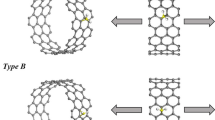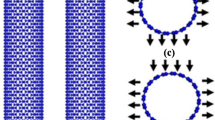Abstract
CNTs produced by traditional physical and chemical methods inevitably have some defects. The existence of defects has a great impact on the physical, chemical and mechanical properties of CNTs. This article presents a method for evaluating the influence of vacancy defects on the fracture mechanism of carbon nanotubes using the C–C bond fracture criterion. The objective of this approach is to develop a finite element model of carbon nanotubes that includes atomic vacancy defects, allowing for the analysis of the evolution of these defects into dislocations. Specifically, this study utilizes a finite element model to simulate the fracture behavior of carbon nanotubes. Additionally, X-ray diffractometer and Raman spectrometer techniques are employed to characterize and analyze complete carbon nanotubes with atomic vacancies and defects throughout the evolution process. The findings indicate that vacancy defects significantly reduce the tensile strength and ultimate strain of Carbon nanotubes, with reductions of approximately 20–30% and 12–18% in tensile strength and final strain, respectively. The diffraction and Raman spectra uncover the evolution mechanism of carbon nanotubes from point defects to dislocation until fracture, and further demonstrate the substantial decrease in their mechanical properties resulting from stress concentration.









Similar content being viewed by others
Data and code availability
The datasets used and/or analyzed during the current study are available from the corresponding author upon reasonable request.
References
Krishnan A, Dujardin E, Treacy MMJ, Hugdahl J, Ebbesen TW (1997) Graphitic cones and the nucleation of curved carbon surfaces. Nature 388(6641):451–454
Yao Z, Zhu CC, Cheng M, Liu J (2001) Mechanical properties of carbon nanotube by molecular dynamics simulation. Comput Mater Sci 22(3–4):180–184
Ariawan D, Smaradhana DF, Akbar HI (2020) Micromechanical analysis of elastic modulus and tensile strength on randomised discontinuous alkali and heat treated kenaf fiber—unsaturated polyester composites. In: Proceedings of the 6th international conference and exhibition on sustainable energy and advanced materials
Trerayapiwat KJ, Lohmann S, Ma X, Sharifzadeh S (2021) Tuning spin–orbit coupling in (6,5) single-walled carbon nanotube doped with sp3 defects. J Appl Phys 129(1):014309
Sharma S, Chandra R, Kumar P, Kumar N (2014) Effect of stone-wales and vacancy defects on elastic moduli of CNTs and their composites using molecular dynamics simulation. Comput Mater Sci 86:1–8
Sharma SK, Saini S, Srivastava AP, Pujari PK (2021) Identification of chemical surrounding and type of vacancy defects in the damaged region of ion irradiated Ni–Cr alloy. Materialia 15:100999
Omari R, Almahmoud E, Talla JA, Al-Khaza’Leh K, Al-Diabat A (2020) Influence of substitutional doping on the electronic properties of CNTs with stone wales defects: density functional calculations. Fuller Nanotub Carb Nanostructures 28(10):1–13
Yu H, Luo H, Cai J, Dong C (2020) Molecular and atomic adsorptions of hydrogen, oxygen, and nitrogen on defective CNTs : a first-principles study. Int J Hydrog Energy 45(51):26655–26665
Roohi H, Jahantab M, Yakta M (2015) Effect of the stone–wales (sw) defect on the response of bnnt to axial tension and compression: a quantum chemical study. Struct Chem 26(1):11–22
Mirnezhad M, Ansari R, Falahatgar SR (2020) Quantum effects on the mechanical properties of fine-scale cnts: an approach based on DFT and molecular mechanics model. Eur Phys J Plus 135(11):908
Wang Z, Korobeinyk A, Whitby RLD, Meikle ST, Mikhalovsky SV, Acquah SFA et al (2010) Direct confirmation that CNTs still react covalently after removal of acid-oxidative lattice fragments. Carbon 48(3):916–918
Ng K, Dai Q (2011) Investigation of fracture behavior of heterogeneous infrastructure materials with extended-finite-element method and image analysis. J Mater Civ Eng 23(12):1662–1671
Serizawa H, Tomiyama S, Hajima T, Murakawa H (2011) Basic analysis of microstructural fracture behavior in structural materials by using fem with interface element. Procedia Engineering 10(7):556–561
Daly M, Reeve M, Veer Singh C (2015) Effects of topological point reconstructions on the fracture strength and deformation mechanisms of graphene. Comput Mater Sci 97:172–180
Ali D, Sen S (2016) Finite element analysis of the effect of boron nitride nanotubes in beta tricalcium phosphate and hydroxyapatite elastic modulus using the RVE model. Compos B 90:336–340
Zhang MBJ, Zhang J et al (2023) Effect of different sp2 bond contents on the reactivity and mechanical properties of coke carbon: a reaxff molecular dynamics study. ACS Omega 8(40):37043–37053
Acknowledgements
This work was supported by the National Key R&D Program of China (No. 2022YFF0608600).
Author information
Authors and Affiliations
Contributions
YaLei Wang contributed to conceptualization, methodology, experiment, data curation and writing—original draft preparation. JianQiu Zhou contributed to supervision, reviewing. Lei Cui contributed to visualization and investigation. Xiaohan Liu contributed to data collection and editing. Xiaocong Tang contributed to data collection.
Corresponding author
Ethics declarations
Competing interest
The authors declare that they have no known competing financial interests or personal relationships that could have appeared to influence the work reported in this paper.
Ethical approval
Not Applicable. No animals were harmed in the study.
Additional information
Handling Editor: Annela M. Seddon.
Publisher's Note
Springer Nature remains neutral with regard to jurisdictional claims in published maps and institutional affiliations.
Rights and permissions
Springer Nature or its licensor (e.g. a society or other partner) holds exclusive rights to this article under a publishing agreement with the author(s) or other rightsholder(s); author self-archiving of the accepted manuscript version of this article is solely governed by the terms of such publishing agreement and applicable law.
About this article
Cite this article
Wang, Y., Zhou, J., Cui, L. et al. Effects of atomic vacancy defects and their evolution mechanisms on the fracture of carbon nanotubes. J Mater Sci 59, 4186–4197 (2024). https://doi.org/10.1007/s10853-024-09495-7
Received:
Accepted:
Published:
Issue Date:
DOI: https://doi.org/10.1007/s10853-024-09495-7




